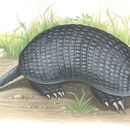en
names in breadcrumbs


Perception Channels: tactile ; chemical
CITES: no special status
IUCN Red List of Threatened Species: data deficient
C. centralis eat some species of insects that are harmful to farm crops. They are not considered a threat to crops like some other species of armadillos.
Diet consists almost exclusively of insects. These include larvae and adult scarab beetles, termites, and ants. They are also known to eat earthworms, bird eggs, and small reptiles and amphibians. C. centralis, like other armadillo species, use their digging abilities to burrow into termite mounds in search of food. Prey is extracted from the tunnels by a long, extensible tongue. They can locate insects in the soil by their keen sense of smell.
Cabassous centralis is found in South America, including the area east of the Andes from northern Argentina to Colombia. It is also found in Central America from Panama into Guatemala (Peten region).
Biogeographic Regions: neotropical (Native )
Generally inhabit grasslands and wooded areas. Prefer areas with thick vegetation as a method of hiding from predators. They live in burrows with the entrance opening to open ground or the base of an embankment.
Terrestrial Biomes: savanna or grassland ; forest ; rainforest ; scrub forest
The body of Cabassous centralis ranges from 30 cm to 71 cm. The tail varies from 10 cm to 18 cm. Cabassous centralis is called the naked-tail armadillo because its tail lacks the protective, keratinous plates found on its body. They are also called eleven-banded armadillos for the number of bands that make up their "armor." Some hair can be found in the spaces between the bands, on the limbs, and on the ventral surface of the body. Large claws adapted for digging are found on both the forefeet and hindfeet. The middle claw is especially large and sickle-shaped. Coloration is dark brown to almost black with yellow lateral areas and a yellow-gray underside. The head is broad with a short, wide snout and well-separated ears. This species walks on the tips of its claws on its forefeet and on the soles of the hindfeet. It is capable running rapidly for short distances to escape danger.
Range mass: 2 to 3 kg.
Other Physical Features: endothermic ; homoiothermic; bilateral symmetry
Average basal metabolic rate: 4.812 W.
Not much research has been done specifically on the reproduction patterns of C. centralis.
Key Reproductive Features: gonochoric/gonochoristic/dioecious (sexes separate); sexual
Average number of offspring: 1.
The northern naked-tailed armadillo (Cabassous centralis) is a species of armadillo.[3] It is one of only two species of armadillo found outside of South America, the other being the more widely distributed nine-banded armadillo.
The northern naked-tailed armadillo is relatively small for an armadillo, with adults measuring 31 to 42 cm (12 to 17 in) in length, with an 11 to 18 cm (4.3 to 7.1 in) tail, and weighing from 2 to 3.5 kg (4.4 to 7.7 lb). They have a short, broad snout, large, funnel-shaped ears, and small eyes. Unlike other armadillos with which they might be confused, they have no scales on the backs of their ears.[4]
The upper body is covered in multiple, squarish scutes, that are arranged in ten to thirteen bands which allow the animal some flexibility. Compared with some other armadillo species, the bands are indistinct. The carapace is generally dark grey-brown in color, with a yellowish tinge to the lower margin. The tail has thinner plates, which are more widely spaced, and somewhat pinkish. The underside of the animal has numerous tufts of hair arranged in about twenty regular bands. The forefeet have five claws, with the middle claw being greatly enlarged into a sickle shape. They have been described as possessing a pungent, musky odor.[4]
It is found from Chiapas in southern Mexico to western Colombia, northwestern Ecuador and northwestern Venezuela, at altitudes from sea level to 3000 m. Its habitats include tropical dry forest, moderately moist forest, cloud forest and forest edges, including secondary and agriculturally disturbed forest, as well as in dry savanna and Colombian subpáramo.[1] However, it appears to prefer undisturbed primary forest, and thus may be vulnerable to deforestation and other forms of habitat disturbance.[1] There are no recognised subspecies.
This armadillo is seldom sighted, and may be rare and/or patchily distributed.[1] It is a solitary insectivore, feeding mainly on ants and termites. One of the most fossorial of all armadillos, it spends most of its time underground in tunnels. Unusually, it rotates its body like an auger as it digs, using the large claws on its fore-feet. It has been reported to make low growling sounds and gurgling squeals, doing so loudly when it is captured, as well as urinating and defecating to discourage its captor.[4]
Mothers give birth to only a single young at a time. Newborns are blind, deaf, and hairless, with soft, pink skin, although the scutes are already visible. They have been reported to live for over seven years.[4]
The northern naked-tailed armadillo (Cabassous centralis) is a species of armadillo. It is one of only two species of armadillo found outside of South America, the other being the more widely distributed nine-banded armadillo.